- Home
- Oliver Sacks
1996 - The Island of the Colorblind
1996 - The Island of the Colorblind Read online
Oliver Sacks
The Island of the Colorblind
And Cydad island
1996
Oliver Sacks has always been fascinated by islands—their remoteness, their mystery, above all the unique forms of life they harbor. For him, islands conjure up equally the romance of Melville and Stevenson, the adventure of Magellan and Cook, and the scientific wonder of Darwin and Wallace.
Drawn to the tiny Pacific atoll of Pingelap by intriguing reports of an isolated community of islanders born totally color-blind, Sacks finds himself setting up a clinic in a one-room island dispensary, where he listens to these achromatopic islanders describe their colorless world in rich terms of pattern and tone, luminance and shadow. And on Guam, where he goes to investigate the puzzling neurodegenerative paralysis endemic there for a century, he becomes, for a brief time, an island neurologist, making house calls with his colleague John Steele, amid crowing cockerels, cycad jungles, and the remains of a colonial culture.
The islands reawaken Sacks’ lifelong passion for botany—in particular, for the primitive cycad trees, whose existence dates back to the Paleozoic—and the cycads are the starting point for an intensely personal reflection on the meaning of islands, the dissemination of species, the genesis of disease, and the nature of deep geologic time. Out of an unexpected journey, Sacks has woven an unforgettable narrative which immerses us in the romance of island life, and shares his own compelling vision of the complexities of being human.
Preface
This book is really two books, independent narratives of two parallel but independent journeys to Micronesia. My visits to these islands were brief and unexpected, not part of any program or agenda, not intended to prove or disprove any thesis, but simply to observe. But if they were impulsive and unsystematic, my island experiences were intense and rich, and ramified in all sorts of directions which continually surprised me.
I went to Micronesia as a neurologist, or neuroanthropolo-gist, intent on seeing how individuals and communities responded to unusual endemic conditions – a hereditary total colorblindness on Pingelap and Pohnpei; a progressive, fatal neurodegenerative disorder on Guam and Rota. But I also found myself riveted by the cultural life and history of these islands, their unique flora and fauna, their singular geologic origins. If seeing patients, visiting archeological sites, wandering in rain forests, snorkelling in the reefs, at first seemed to bear no relation to each other, they then fused into a single unpartition-able experience, a total immersion in island life.
But perhaps it was only on my return, when the experiences recollected and reflected themselves again and again, that their connection and meaning (or some of their meanings) started to grow clear; and with this, the impulse to put pen to paper. Writing, in these past months, has allowed me, forced me, to revisit these islands in memory. And since memory, as Edelman reminds us, is never a simple recording or reproduction, but an active process of recategorization – of reconstruction, of imagination, determined by our own values and perspectives – so remembering has caused me to reinvent these visits, in a sense, constructing a very personal, idiosyncratic, perhaps eccentric view of these islands, informed in part by a lifelong romance with islands and island botany.
From my earliest years I had a passion for animals and plants, a biophilia nurtured first by my mother and my aunt, then by favorite teachers and the companionship of school friends who shared these passions: Eric Korn, Jonathan Miller, and Dick Lindenbaum. We would go plant-hunting together, vascula strapped to our backs; on frequent freshwater expeditions, at dawn; and for a fortnight of marine biology at Millport each spring. We discovered and shared books – I got my favorite Strasburger’s Botany (I see from the flyleaf) from Jonathan in 1948, and innumerable books from Eric, already a bibliophile. We spent hundreds of hours at the zoo, at Kew Gardens, and in the Natural History Museum, where we could be vicarious naturalists, travel to our favorite islands, without leaving Regent’s Park or Kew or South Kensington.
Many years later, in the course of a letter, Jonathan looked back on this early passion, and the somewhat Victorian character which suffused it: ‘I have a great hankering for that sepia-tinted era,’ he wrote. ‘I regret that the people and the furniture about me are so brightly colored and clean. I long endlessly for the whole place suddenly to be plunged into the gritty monochrome of 1876.’
Eric felt similarly, and this is surely one of the reasons why he has come to combine writing, book collecting, book buying, book selling, with biology, becoming an antiquarian with a vast knowledge of Darwin, of the whole history of biology and natural science. We were all Victorian naturalists at heart.
In writing about my visits to Micronesia, then, I have gone back to old books, old interests and passions I have had for forty years, and fused these with the later interests, the medical self, which followed. Botany and medicine are not entirely unallied. The father of British neurology, W.R. Gowers, I was delighted to learn recently, once wrote a small botanical monograph – on Mosses. In his biography of Gowers, Macdonald Critchley remarks that Gowers ‘brought to the bedside all his skill as a natural historian. To him the neurological sick were like the flora of a tropical jungle.…’
In writing this book, I have travelled into many realms not my own, and I have been greatly helped by many people, especially those people of Micronesia, of Guam and Rota and Pingelap and Pohnpei – patients, scientists, physicians, botanists – whom I encountered on the way. Above all, I am grateful to Knut Nordby, John Steele, and Bob Wasserman for sharing the journey with me, in many ways. Among those who welcomed me to the Pacific, I must thank in particular Ulla Craig, Greg Dever, Delihda Isaac, May Okahiro, Bill Peck, Phil Roberto, Julia Steele, Alma van der Velde, and Marjorie Whiting. I am grateful also to Mark Futterman, Jane Hurd, Catherine de Laura, Irene Maumenee, John Mollon, Britt Nordby, the Schwartz family, and Irwin Siegel for their discussions of achromatopsia and of Pingelap. Special thanks are due to Frances Futterman, who, among other things, introduced me to Knut and provided invaluable advice on selecting sunglasses and equipment for our expedition to Pingelap, in addition to sharing her own experience of achromatopsia.
I am likewise indebted to many researchers who have played a part in investigating the Guam disease over the years: Sue Daniel, Ralph Garruto, Carleton Gajdusek, Asao Hirano, Leonard Kurland, Andrew Lees, Donald Mulder, Peter Spencer, Bert Wiederholt, Harry Zimmerman. Many others have helped in all sorts of ways, including my friends and colleagues Kevin Cahill (who cured me of amebiasis contracted in the islands), Elizabeth Chase, John Clay, Allen Furbeck, Stephen Jay Gould, G.A. Holland, Isabelle Rapin, Gay Sacks, Herb Schaumburg, Ralph Siegel, Patrick Stewart, and Paul Theroux.
My visits to Micronesia were greatly enriched by the documentary film crew which accompanied us there in 1994, and shared all of these experiences with us (and got a great many of them on film, despite often difficult conditions). Emma Crichton-Miller, first, provided a great deal of research on the islands and their people, and Chris Rawlence produced and directed the filming with infinite sensitivity and intelligence. The film crew – Chris and Emma, David Barker, Greg Bailey, Sophie Gardiner, and Robin Probyn – enlivened our visit with skill and camaraderie, and not least as friends, who have now accompanied me on many different adventures.
I am grateful to those who have helped in the course of writing and publishing this book, particularly Nicholas Blake, Suzanne Gluck, Jacqui Graham, Schellie Hagan, Carol Harvey, Claudine O’Hearn, Heather Schroder, and especially Juan Martinez, who has skillfully and intelligently organized in innumerable ways.
Though the book was written in a sort of swoop, a single breath, in July 1995, it then grew
, like an unruly cycad, to many times its original size, putting out offshoots and bulbils in all directions. Since the offshoots, in volume, now started to vie with the text, and since I felt it crucial to keep the narrative unencumbered, I have placed many of these additional thoughts together, as endnotes. The complexities of what to put in and leave out, of how to orchestrate the five parts of this narrative, owe a great deal to the sensitivity and judgment of Dan Frank, my editor at Knopf, and to Kate Edgar.
I owe a special debt to Tobias Picker’s version of The Encan-tadas. The fusion of Picker’s music, Melville’s text, and Giel-gud’s voice exerted a disturbing and mysterious effect upon me, and whenever, in the writing, memory failed me, listening to this piece operated as a sort of Proustian mnemonic, transporting me back to the Marianas and the Carolines.
For sharing their expertise and enthusiasm on botanical subjects, most especially on ferns and cycads, I am grateful to Tom Mirenda and Mobee Weinstein, to Bill Raynor, Lynn Raulerson, and Agnes Rinehart in Micronesia, to Chuck Hubbuch at the Fairchild Tropical Garden in Miami and to John Mickel and Dennis Stevenson at the New York Botanical Garden. And finally, for their patient and careful readings of the manuscript of this book, I am indebted to Stephen Jay Gould and Eric Korn. It is to Eric, my oldest and dearest friend and companion in all sorts of scientific enthusiasms over the years, that I dedicate this book.
New York August 1996
O.W.S.
Book I
THE ISLAND OF THE COLORBLIND
Island Hopping
Islands have always fascinated me; perhaps they fascinate everyone. The first summer holiday I remember – I was just three years old – was a visit to the Isle of Wight. There are only fragments in memory – the cliffs of many-colored sands, the wonder of the sea, which I was seeing for the first time: its calmness, its gentle swell, its warmth, entranced me; its roughness, when the wind rose, terrified me. My father told me that he had won a race swimming round the Isle of Wight before I was born, and this made me think of him as a giant, a hero. Stories of islands, and seas, and ships and mariners entered my consciousness very early – my mother would tell me about Captain Cook, about Magellan and Tasman and Dampier and Bougainville, and all the islands and peoples they had discovered, and she would point them out to me on a globe. Islands were special places, remote and mysterious, intensely attractive, yet frightening too. I remember being terrified by a children’s encyclopedia with a picture of the great blind statues of Easter Island looking out to sea, as I read that the islanders had lost the power to sail away from the island and were totally cut off from the rest of humanity, doomed to die in utter isolation.1
I read about castaways, desert islands, prison islands, leper islands. I adored The Lost World, Conan Doyle’s splendid yarn about an isolated South American plateau full of dinosaurs and Jurassic life-forms – in effect, an island marooned in time (I knew the book virtually by heart, and dreamed of growing up to be another Professor Challenger).
I was very impressionable and readily made other people’s imaginings my own. H.G. Wells was particularly potent – all desert islands, for me, became his Aepyornis Island or, in a nightmare mode, the Island of Dr. Moreau. Later, when I came to read Herman Melville and Robert Louis Stevenson, the real and the imaginary fused in my mind. Did the Marquesas actually exist? Were Omoo and Typee actual adventures? I felt this uncertainty most especially about the Galapagos, for long before I read Darwin, I knew of them as the ‘evilly enchanted’ isles of Melville’s Encantadas.
Later still, factual and scientific accounts began to dominate my reading – Darwin’s Voyage of the Beagle, Wallace’s Malay Archipelago, and my favorite, Humboldt’s Personal Narrative (I loved especially his description of the six-thousand-year-old dragon tree on Teneriffe) – and now the sense of the romantic, the mythical, the mysterious, became subordinated to the passion of scientific curiosity.2
For islands were, so to speak, experiments of nature, places blessed or cursed by geographic singularity to harbor unique forms of life – the aye-ayes and pottos, the lorises and lemurs of Madagascar; the great tortoises of the Galapagos; the giant flightless birds of New Zealand – all singular species or genera which had taken a separate evolutionary path in their isolated habitats.3 And I was strangely pleased by a phrase in one of Darwin’s diaries, written after he had seen a kangaroo in Australia and found this so extraordinary and alien that he wondered if it did not represent a second creation.4
As a child I had visual migraines, where I would have not only the classical scintillations and alterations of the visual field, but alterations in the sense of color too, which might weaken or entirely disappear for a few minutes. This experience frightened me, but tantalized me too, and made me wonder what it would be like to live in a completely colorless world, not just for a few minutes, but permanently. It was not until many years later that I got an answer, at least a partial answer, in the form of a patient, Jonathan I., a painter who had suddenly become totally colorblind following a car accident (and perhaps a stroke). He had lost color vision not through any damage to his eyes, it seemed, but through damage to the parts of the brain which ‘construct’ the sensation of color. Indeed, he seemed to have lost the ability not only to see color, but to imagine or remember it, even to dream of it. Nevertheless, like an amnesic, he in some way remained conscious of having lost color, after a lifetime of chromatic vision, and complained of his world feeling impoverished, grotesque, abnormal – his art, his food, even his wife looked ‘leaden’ to him. Still, he could not assuage my curiosity on the allied, yet totally different, matter of what it might be like never to have seen color, never to have had the least sense of its primal quality, its place in the world.
Ordinary colorblindness, arising from a defect in the retinal cells, is almost always partial, and some forms are very common: red-green colorblindness occurs to some degree in one in twenty men (it is much rarer in women). But total congenital colorblindness, or achromatopsia, is surpassingly rare, affecting perhaps only one person in thirty or forty thousand. What, I wondered, would the visual world be like for those born totally colorblind? Would they, perhaps, lacking any sense of something missing, have a world no less dense and vibrant than our own? Might they even have developed heightened perceptions of visual tone and texture and movement and depth, and live in a world in some ways more intense than our own, a world of heightened reality – one that we can only glimpse echoes of in the work of the great black-and-white photographers? Might they indeed see us as peculiar, distracted by trivial or irrelevant aspects of the visual world, and insufficiently sensitive to its real visual essence? I could only guess, as I had never met anyone born completely colorblind.
Many of H.G. Wells’ short stories, it seems to me, fantastical as they are, can be seen as metaphors for certain neurological and psychological realities. One of my favorites is ‘The Country of the Blind,’ in which a lost traveller, stumbling into an isolated valley in South America, is struck by the strange ‘parti-coloured’ houses that he sees. The men who built these, he thinks, must have been as blind as bats – and soon he discovers that this is the case, and indeed that he has come across an entire blind society. He finds that their blindness is due to a disease contracted three hundred years before, and that over the course of time, the very concept of seeing has vanished:
For fourteen generations these people had been blind and cut off from all the seeing world; the names for all the things of sight had faded and changed…Much of their imagination had shrivelled with their eyes, and they had made for themselves new imaginations with their ever more sensitive ears and finger-tips.
Wells’ traveller is at first contemptuous of the blind, seeing them as pitiful, disabled – but soon the tables are reversed, and he finds that they see him as demented, subject to hallucinations produced by the irritable, mobile organs in his face (which the blind, with their atrophied eyes, can conceive only as a source of delusion). When he falls in love with a girl in
the valley and wants to stay there and marry her, the elders, after much thought, agree to this, provided he consent to the removal of those irritable organs, his eyes.
Forty years after I first read this story, I read another book, by Nora Ellen Groce, about deafness on the island of Martha’s Vineyard. A sea captain and his brother from Kent, it seems, had settled there in the 1690s; both had normal hearing, but both brought with them a recessive gene for deafness. In time, with the isolation of the Vineyard, and the intermarriage of its close community, this gene was carried by the majority of their descendants; by the mid-nineteenth century, in some of the up-island villages, a quarter or more of the inhabitants were born totally deaf.
Hearing people were not so much discriminated against here as assimilated – in this visual culture, everyone in the community, deaf and hearing alike, had come to use sign language. They would chat in Sign (it was much better than spoken language in many ways: for communicating across a distance, for instance, from one fishing boat to another, or for gossiping in church), debate in Sign, teach in Sign, think and dream in Sign. Martha’s Vineyard was an island where everyone spoke sign language, a veritable country of the deaf. Alexander Graham Bell, visiting in the 1870s, wondered indeed whether it might not come to harbor an entire ‘deaf variety of the human race,’ which might then spread throughout the world.
And knowing that congenital achromatopsia, like this form of deafness, is also hereditary, I could not help wondering whether there might also be, somewhere on the planet, an island, a village, a valley of the colorblind.
When I visited Guam early in 1993, some impulse made me put this question to my friend John Steele, who has practiced neurology all over Micronesia. Unexpectedly, I received an immediate, positive answer: there was just such an isolate, John said, on the island of Pingelap – it was relatively close, ‘barely twelve hundred miles from here,’ he added. Just a few days earlier, he had seen an achromatopic boy on Guam, who had journeyed there with his parents from Pingelap. ‘Fascinating,’ he said. ‘Classical congenital achromatopsia, with nystagmus, and avoidance of bright light – and the incidence on Pingelap is extraordinarily high, almost ten percent of the population.’ I was intrigued by what John told me, and resolved that – sometime – I would come back to the South Seas and visit Pingelap.

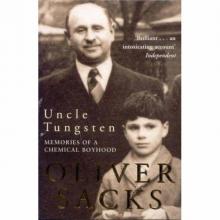 Uncle Tungsten
Uncle Tungsten Oaxaca Journal
Oaxaca Journal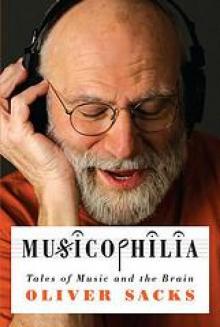 Musicophilia
Musicophilia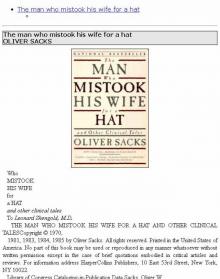 The man who mistook his wife for a hat
The man who mistook his wife for a hat 1989 - Seeing Voices
1989 - Seeing Voices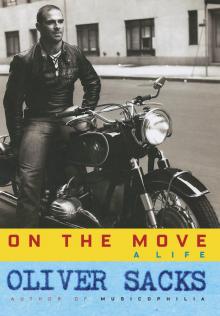 On the Move: A Life
On the Move: A Life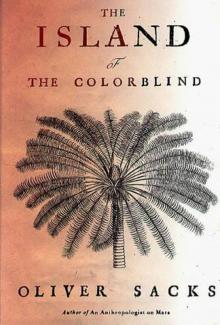 1996 - The Island of the Colorblind
1996 - The Island of the Colorblind An Anthropologist on Mars: Seven Paradoxical Tales
An Anthropologist on Mars: Seven Paradoxical Tales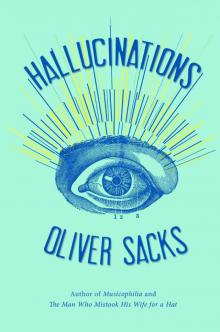 Hallucinations
Hallucinations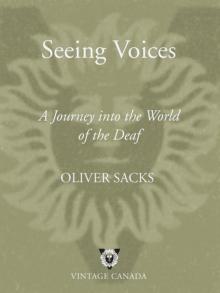 Seeing Voices
Seeing Voices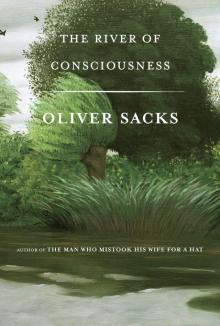 The River of Consciousness
The River of Consciousness Vintage Sacks
Vintage Sacks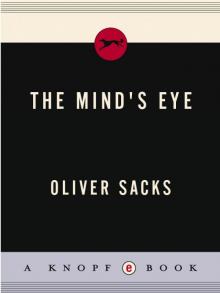 The Mind's Eye
The Mind's Eye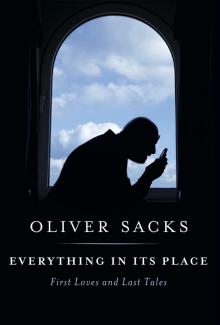 Everything in Its Place
Everything in Its Place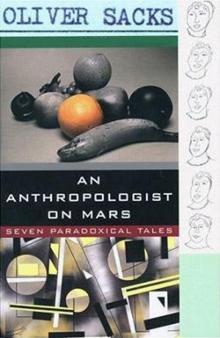 An Anthropologist on Mars (1995)
An Anthropologist on Mars (1995)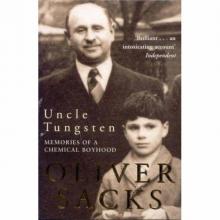 Uncle Tungsten: Memories of a Chemical Boyhood (2001)
Uncle Tungsten: Memories of a Chemical Boyhood (2001)